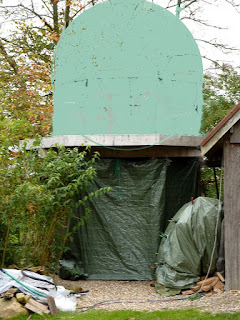*
In
theory I ought to be able to measure the circumference at different
heights on the dome and divide by 16 to find the strut lengths. If only
it were that simple! The polygons involved are not true circles and the
shape of the dome is not perfect until it really is perfect.
I
could ignore the polygons and run my long cloth tape measure around the
dome resting on panel pins driven into the ribs at the correct
'latitude' for the struts. [Bottom of the intended strut where it is longest] The panel pins would stop the tape from slipping
downwards. That might be worth a try with bare ribs with only base
struts. Variations in rib spacing would not affect the results. I'd just
need to remove 16 ribs from the hip, waist and chest measurements.
The observation slit is treated as the last gore going in either direction. As that demands the dome is cut away this would nullify any variations. I just need to make the dome as even as possible before attacking it with the tape measure. This allows me to cut struts of equal length for each ring. Based on real world figures for the circumference at each 50cm higher level. Better than guessing by measuring each gore and averaging the difference as I have done so far? Not really sure.
I
am aware that I could glue the ribs together in pairs for greater
stiffness. The horizontal struts could be held in place by skewed screws
passing through two ribs from above and below the adjacent struts. They
don't have to have screws straight into their end grain through just
one thickness of rib.

I have to constantly keep in mind
the difficulty of getting useful structure up onto the top of the
octagon walls. Not to mention the added height of the supporting wheels and both base rings. [Walls and dome]
Anything too heavy or unwieldy will make it simply too dangerous or
unnecessarily difficult. Particularly in windy weather working well above the ground.
A quick mock-up of the octagon using lightweight tarpaulins and a garden
net. It was wet and windy so I had to time my shot carefully. I haven't
clad the building with plywood yet because I thought it might interfere
with building the dome up on top.
One
injury from heavy lifting could put an end to the entire project. I
still tend to try and lift heavy things as if I were a teenager. In
middle age I would lift ridiculous weights and did all day, most days
when I was landscaping a very rocky moraine, by hand, right next to the house.
There was no room for a digger even if I had wanted one. I wheel-barrowed away the results of my exhausting digging with a navvy's
pick and shovel. Of which I wore out several of each.
Rocks up to 3' across were rolled away some thirty yards to provide a level lawn or terrace. Larger rocks were moved constantly backwards against the rising and receding bank of highly compacted gravel yet to be attacked. I removed probably 5x15x3m of rock hard gravel that way over a couple of years. Every, single teaspoonful was hard won. It took years for the damage to my shoulders to recover.
Repeated lifting, bending and moving about is
still keeping me fit. As is the rough, country walking and reduced cycle rides. But there are
obviously limits. I have no plans to become a weight lifter in a gym
just to become strong enough to lift the complete dome with one hand!
I'll settle for carrying one complete gore at a time up a ladder.

Wednesday: A grey, dull day with the threat of rain in the afternoon.
The octagon mock-up with a rather bright green dome painted on top, roughly to scale. The planned colour is 'dirty' pale sage. The observatory walls will be dull, grey-brown plywood not green as shown here.
A rest day from the dome for consolidation of theory and practice in my mind. I need more strut material which means taking the car out tomorrow morning in the rain. I keep cutting new struts from previous iterations/lengths but inevitably this uses up the longer lengths. Which then have to be replaced.
Without measuring the actual dome I am fairly certain the previous struts were not long enough. By pulling in the gores too tightly, lower down, this 'tipped' them upwards and outwards at their tops. So the supposed hemisphere became more pointed towards the pole by at least 15cm, or 6". Not quite your Kremlin dome but similar.
Click on any image for an enlargement.
*








